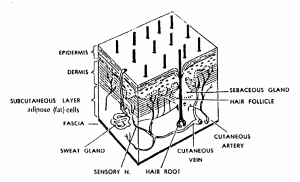Burns can be classified by the depth of the burn (the number of damaged tissue layers).
A burn can be a first-degree burn, a second-degree burn, or a third degreeburn. Different areas may be burned to a different degree. A third degree burn may be surrounded by an area of second-degree burns that, in turn, may be surrounded by first-degree burns.
a. Skin Layers.
The skin consists of three primary layers, the epidermis, the dermis, and the subcutaneous tissue (figure 6-1). Beneath the subcutaneous layer is the fascia. The fascia covers the muscles that lie beneath the skin.
(1) Epidermis. The epidermis is the outer layer of the skin. This layer consists of dead cells that are constantly being rubbed off and replaced from beneath. The epidermis contains no blood vessels or nerves, but does contain the pigments that give the skin color.
(2) Dermis. The dermis (true skin) layer lies under the epidermis. The dermis contains sweat glands, sebaceous (oil) glands, hair follicles, small blood vessels (but not major blood vessels), and specialized nerve endings.
(3) Subcutaneous tissue. The subcutaneous tissue lies beneath the dermis and is composed primarily of fat. The fat serves as an insulator against cold temperatures.

b. Degrees (Depth) of Burn.
(1) First-degree burns. First-degree burns cause the skin to be red and painful (like a sunburn), but does not produce blisters. It involves only the superficial skin (epidermis).
(2) Second-degree burns. Second-degree burns are more serious. The burn is painful and blisters are present. There is damage to the epidermis and the dermis. There may also be some swelling in the subcutaneous layer even though the layer is not actually damaged.
(3) Third-degree burns. Third-degree burns involve damage to or destruction of all three layers of skin. It usually involves damage to the fascia and may also include damage to underlying muscles, nerves, blood vessels, and/or bone. The skin may look leathery, dry, and discolored (charred, brown, or white). Clotted blood vessels may be visible under the burned area and subcutaneous fat may be visible. Third degree burns may not be painful because the nerves have been destroyed, but the surrounding area with second and first-degree burns may be painful. Third-degree burns involve a large loss of body fluid that can lead to shock.
